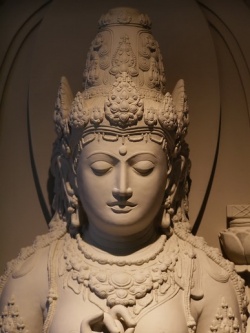Difference between revisions of "Cātummahārājikā"
m (Text replacement - "Category:Pali terminology" to "{{PaliTerminology}}") |
|||
| Line 24: | Line 24: | ||
[http://www.palikanon.com/english/pali_names/c/caatummahaaraajikaa.htm palikanon.com] | [http://www.palikanon.com/english/pali_names/c/caatummahaaraajikaa.htm palikanon.com] | ||
| − | + | {{PaliTerminology}} | |
[[Category:Buddhist Terms]] | [[Category:Buddhist Terms]] | ||
[[Category:Deva's]] | [[Category:Deva's]] | ||
Latest revision as of 12:49, 27 April 2014
The inhabitants of the lowest (Cātummahārājika) Deva World.
This World derives its name from the Four Great Kings (Cattāro Mahārājāno) who dwell there as guardians of the four quarters;
- Dhatarattha of the East,
- Virūlhaka of the South,
- Virūpakkha of the West, and
- Vessarana of the North (D.ii.207f; iii.194f).
They keep large retinues consisting, respectively, of Gandhabbas, Kumbhandas, Nāgas and Yakkhas, all of whom dwell in the same World as their lords and accompany them on their travels. These kings are mentioned (D.ii.257f) as having undertaken the protection of The Buddha from the moment of his conception in his mother's womb, and in the ātānātiya Sutta, they appear as Protectors not only of The Buddha but also of his followers (See, e.g., DhA.ii.146; iii.96).
The Four Kings appear to have been regarded as Recorders of the happenings in the assemblies of the devas (D.ii.225). On the eighth day of the lunar half-month, they send their Councillors out into the World to discover if men cultivate righteousness and Virtue; on the fourteenth day they send their sons, on the fifteenth day they themselves appear in the World, all these visits having the same purpose. Then, at the assembly of the devas, they submit their report to the gods of Tāvatimsa, who rejoice or lament according as to whether men prosper in righteousness or not (A.i.142f.; for more details see AA.i.376f).
These four Gods surpass the other inhabitants of their worlds in ten ways - Beauty, length of Life, etc. - because their Merit is greater than that of the others (A.iv.242).
Besides these Regent Gods and their followers, other dwellers are to be found in their World - the Khiddāpadosikā, the Manopadosikā, the Sitavalāhakā, the Unhavalāhakā, and the devaputtas Candima and Suriya (VibhA.519; MNidA.108).
Life in the Cātummahārājikā World lasts, according to human computation, ninety thousand years (DA.ii.472, 647, but see Kvu.207). Beings are born there as a result of various acts of piety and Faith which, however, are based on motives not very exalted (A.iv.60).
The Cātummahārājikā World is situated half-way up Mount Sineru. Some of the devas of the World dwell in the mountain, others in the sky. (On these gods see Moulton: Zoroastrianism 22-7, 242.)
